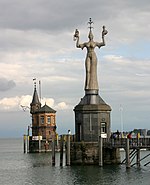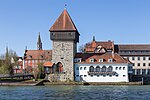Konstanz station
Buildings and structures in Konstanz (district)Railway stations in Baden-WürttembergRailway stations in Germany opened in 1863Railway stations serving harbours and ports

Konstanz station (German: Bahnhof Konstanz) is the largest passenger station in the German city of Konstanz (Constance). It is served by regional and long-distance services operated by Deutsche Bahn and Swiss Federal Railways. It is the end of the High Rhine Railway and the beginning of the Lake Line.
Excerpt from the Wikipedia article Konstanz station (License: CC BY-SA 3.0, Authors, Images).Konstanz station
Bahnhofplatz, Verwaltungsgemeinschaft Konstanz
Geographical coordinates (GPS) Address Nearby Places Show on map
Geographical coordinates (GPS)
| Latitude | Longitude |
|---|---|
| N 47.658753888889 ° | E 9.1773119444444 ° |
Address
Bahnhofplatz
78462 Verwaltungsgemeinschaft Konstanz, Konstanz-Altstadt
Baden-Württemberg, Germany
Open on Google Maps









